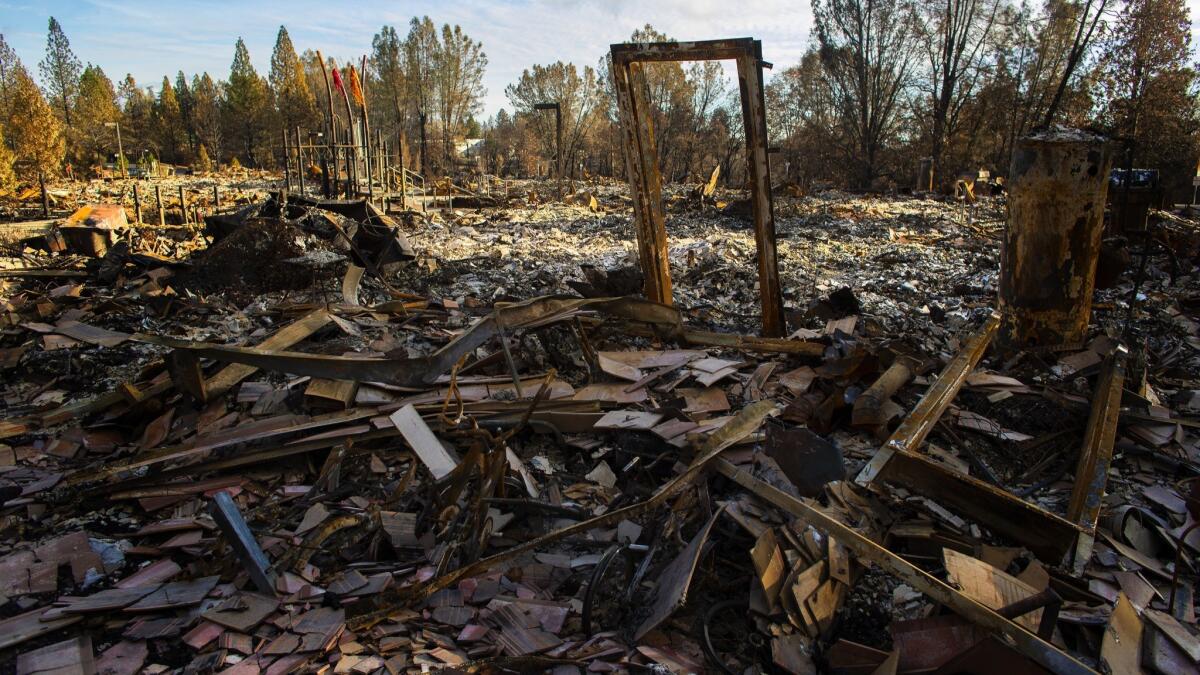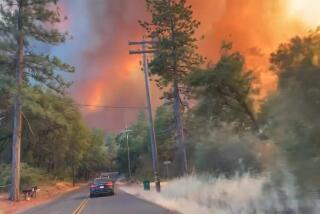How Northern California’s destructive wildfires could exacerbate the state’s housing crisis

Reporting from Paradise, Calif. — Northern California’s recent wildfires have burned homes at a greater pace than developers are building them, deepening a housing shortage that already has left millions struggling to find affordable places to live.
Five large wildfires over the past 14 months, with November’s Camp fire the most devastating, have destroyed nearly 21,000 homes across six counties. That total is equivalent to more than 85% of all the new housing built in those counties over the past decade, according to Construction Industry Research Board building permit statistics.
“We had a housing crisis prior to the fires,” said Bob Raymer, a senior engineer with the California Building Industry Assn. “This only exacerbated the crisis. I can’t even put a measure on it. Just wow.”
‘Where do people go?’: Camp fire makes California’s housing crisis worse »
The devastation from the fires will be felt in the state’s housing market, state officials, academics and other experts said. Rebuilding in affected areas will depend on the pace of debris removal, the ability of property owners to secure payment from their insurance companies, the availability of construction workers and raw materials and a host of other factors. Such efforts could compete with housing and other development in the region, driving up the cost of building and slowing production in other parts of Northern California.
Those effects are likely to worsen housing affordability, said Ben Metcalf, director of the California Department of Housing and Community Development. And the state will face greater challenges if wildfires or other natural disasters continue to wipe out homes in the coming years, he said.
“It puts even more pressure on us to come up with creative solutions to our housing supply problems,” Metcalf said.
Nearly 14,000 homes burned in the Camp fire alone, among them three dozen low-income apartments in Paradise Community Village. All that remains of the complex is burned-out stoves and sinks, blackened tree trunks and the husk of a jungle gym.
The destruction left former residents scrambling. Some stayed with nearby family members and others scattered to the Bay Area, Oregon and even the Midwest.

After struggling to find affordable housing, Nancy Tucker Rich, 64, was one of the first to move into the apartment complex when it opened five years ago. When the fire struck, she stayed with her daughter for eight days before renting a room with a separate entrance in a single-family home in Oroville, about 20 miles from Paradise.
“Everybody needs a place,” said Tucker Rich, who works in the mailroom at the Chico Enterprise-Record newspaper.
Rebuilding in Napa and Sonoma counties is just beginning to pick up steam after last fall’s Tubbs fire, which burned 4,651 homes and now ranks as the state’s second most destructive blaze. The city of Santa Rosa, among the hardest hit by the Tubbs fire, has more than 1,400 homes in various stages of reconstruction.
This summer’s Carr fire in Shasta and Trinity counties destroyed more than 1,000 homes. After the fire, officials in Redding, the largest city in Shasta County, heard from their counterparts in Sonoma County that a shortage of builders was pushing up costs there, Redding City Councilwoman Kristen Schreder said. She fears the effects could be even worse in her community and Butte County as rebuilding efforts get off the ground.
Schreder pointed to $6 billion in new funding for low-income and homeless housing developments approved by California voters in November as a potential source of money to help the neediest residents find permanent homes.
“Certainly there should be prioritization for areas that were impacted by the fires,” Schreder said.
Aside from construction cost increases and the need for new funding, the demand to rebuild homes destroyed by fires might change where development occurs in the state. Robert Eyler, an economics professor at Sonoma State, said the fires shouldn’t affect the pace of housing construction but might redirect some building away from hot markets in Sacramento and Central and Silicon valleys to Butte County.
“Do these fires affect the momentum of housing in California?” Eyler said. “They disturb the momentum, but they don’t mean a negative housing shift.”
There was a severe lack of available homes in fire-affected areas even before the blazes, particularly for lower-income residents. Sonoma County, for instance, needed to triple the number of low-income rentals and add more than 14,000 units to meet demand before the Tubbs fire, according to the California Housing Partnership Corp., a nonprofit low-income housing advocate.
Community Housing Improvement Program, the developer of Paradise Community Village, owns or manages 17 properties in Butte, Shasta and five surrounding counties. It had a wait list of nearly 1,800 families for its homes before the fire. Desiree Gonzalez, a spokeswoman for Community Housing Improvement Program, said her organization would like to rebuild its apartments in Paradise, but it’s too soon to tell if that will be possible.
“Our plan is to rebuild it,” Gonzalez said. “We don’t know if it is going to be feasible to build in that area.”
Tucker Rich, who has lived in the Paradise area on and off for decades, grabbed some bills and her Bible before escaping the morning of the fire. She counts herself lucky to have found a place in Oroville, especially since her new landlord dropped the rent by $200 a month and cut the security deposit in half because she’s a fire victim. The $800 a month she’s paying now is about the same as her housing costs in Paradise, including utilities.
But Tucker Rich isn’t sure she wants to go back to Paradise — it’s too sad there, she said. She’s thinking about buying a mobile home instead. In the meantime, she plans to ask her former neighbors and other residents of Paradise for the keys to their burned houses, businesses and cars for an art project. Rather than throwing the keys away, she said, people might want to display them outside their new homes as a reminder of where they used to live.
“Nobody needs those keys anymore,” she said.
Coverage of California politics »
More to Read
Get the L.A. Times Politics newsletter
Deeply reported insights into legislation, politics and policy from Sacramento, Washington and beyond. In your inbox three times per week.
You may occasionally receive promotional content from the Los Angeles Times.











